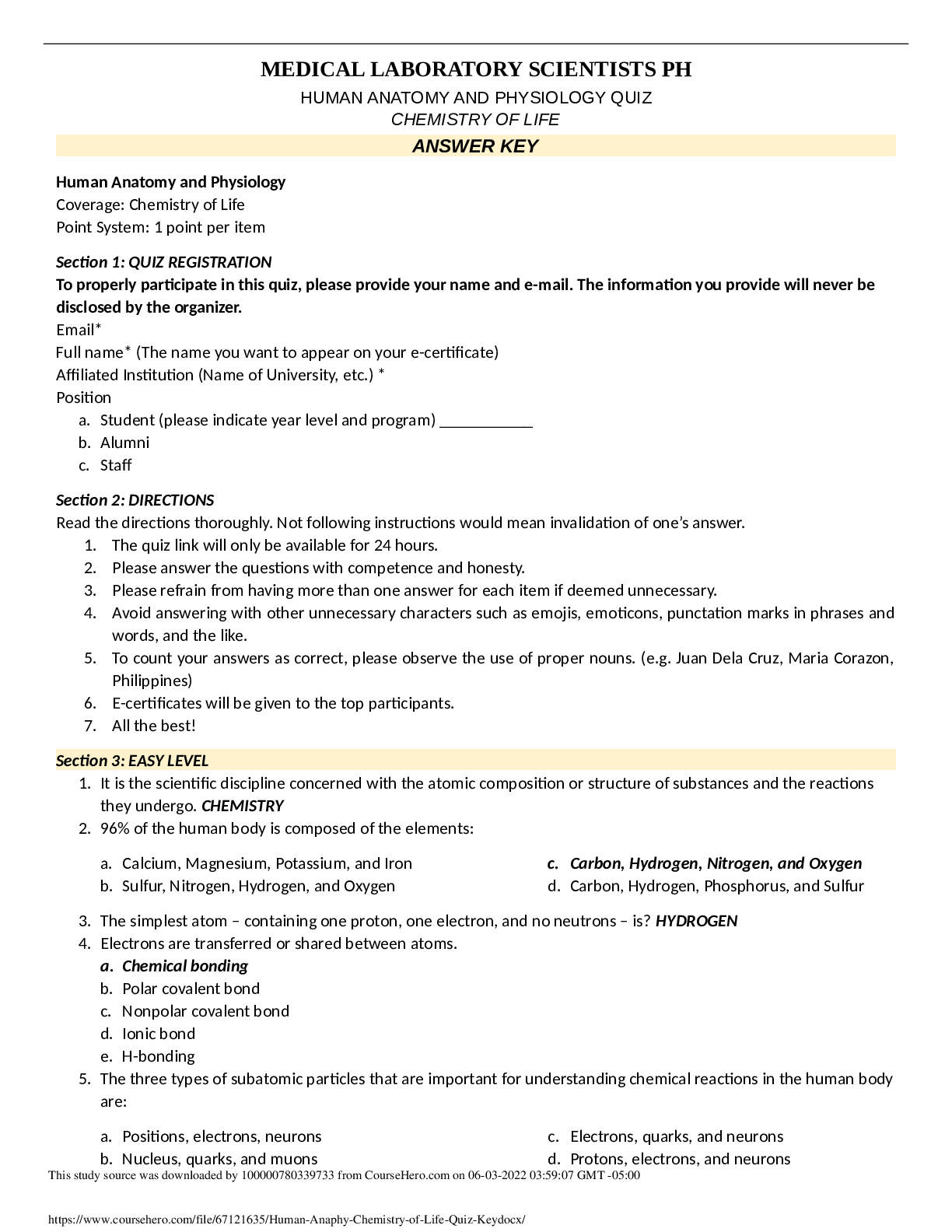Human Anatomy and Physiology
Coverage: Chemistry of Life
Point System: 1 point per item
Section 1: QUIZ REGISTRATION
To properly participate in this quiz, please provide your name and e-mail. The information you provide will never be
disclosed by the organizer.
Email*
Full name* (The name you want to appear on your e-certificate)
Affiliated Institution (Name of University, etc.) *
Position
a. Student (please indicate year level and program) ___________
b. Alumni
c. Staf
Section 2: DIRECTIONS
Read the directions thoroughly. Not following instructions would mean invalidation of one’s answer.
1. The quiz link will only be available for 24 hours.
2. Please answer the questions with competence and honesty.
3. Please refrain from having more than one answer for each item if deemed unnecessary.
4. Avoid answering with other unnecessary characters such as emojis, emoticons, punctation marks in phrases and
words, and the like.
5. To count your answers as correct, please observe the use of proper nouns. (e.g. Juan Dela Cruz, Maria Corazon,
Philippines)
6. E-certificates will be given to the top participants.
7. All the best!
Section 3: EASY LEVEL
1. It is the scientific discipline concerned with the atomic composition or structure of substances and the reactions
they undergo. CHEMISTRY
2. 96% of the human body is composed of the elements:
a.b.Calcium, Magnesium, Potassium, and Iron
Sulfur, Nitrogen, Hydrogen, and Oxygen
c.d.Carbon, Hydrogen, Nitrogen, and Oxygen
Carbon, Hydrogen, Phosphorus, and Sulfur
3. The simplest atom – containing one proton, one electron, and no neutrons – is? HYDROGEN
4. Electrons are transferred or shared between atoms.
a. Chemical bonding
b. Polar covalent bond
c. Nonpolar covalent bond
d. Ionic bond
e. H-bonding
5. The three types of subatomic particles that are important for understanding chemical reactions in the human body
are:
a. Positions, electrons, neurons
c. Electrons, quarks, and neurons
b. Nucleus, quarks, and muons
d. Protons, electrons, and neurons
This study source was downloaded by 100000780339733 from CourseHero.com on 06-03-2022 03:59:07 GMT -05:00
https://www.coursehero.com/file/67121635/Human-Anaphy-Chemistry-of-Life-Quiz-Keydocx/
e. Protons, electrons, and nucleus
6. The protons have a neutral charge.
a. True
b. False, the neurons have neutral charge.
f. Electrons, neutrons, and protons
c. None of the above.
7. A negatively charged atom is called as:
a.b.c.d.Electrolytes
Electrons
Isomers
Protons
e.f.g.Anion
Superoxide
Cation
8. An electrolyte can conduct electrical current when dissolved in water.
a. True
b. False
9. Salts form when an acid reacts with a base.
a. True
b. False
10.This refers to anything that occupies space and has mass. MATTER
11.Which of the following is the smallest particle of an element?
a. Cells
b. Molecule
c. Atoms
d. Hydrocarbons
12.The type of chemical bond that involves the sharing of valence electrons between two atoms.
a. London Dispersion Forces
b. Vander Waal
c. Covalent
d. Hydrogen
e. None of the Above
f. All of the Above except for E.
13.What is the most abundant and most important inorganic compound in the body?
a. Water
b. Sodium chloride
c. Oxygen gas
d. Carbon
e. DNA
f. Proteins
14.Which of the following would you call a solute that readily dissolves in water?
a. Hydrocarbon
b. Carbohydrate
c. Hydrophilic
d. Amphipathic
e. Hydrophobic
f. Hydrostatic
15.Trace elements are required in large amounts. They are found as part of enzymes or required for enzyme
activation.
a. Both sentences are correct.
b. The second sentence is wrong.
This study source was downloaded by 100000780339733 from CourseHero.com on 06-03-2022 03:59:07 GMT -05:00
Read More


